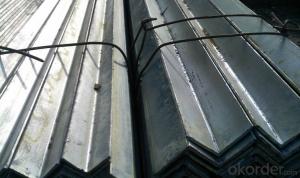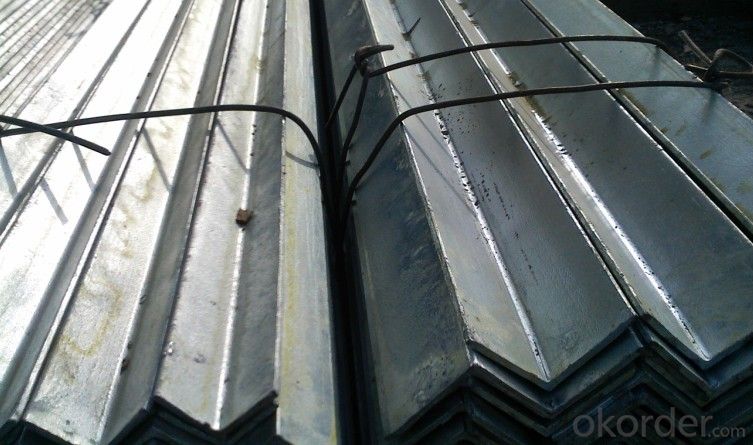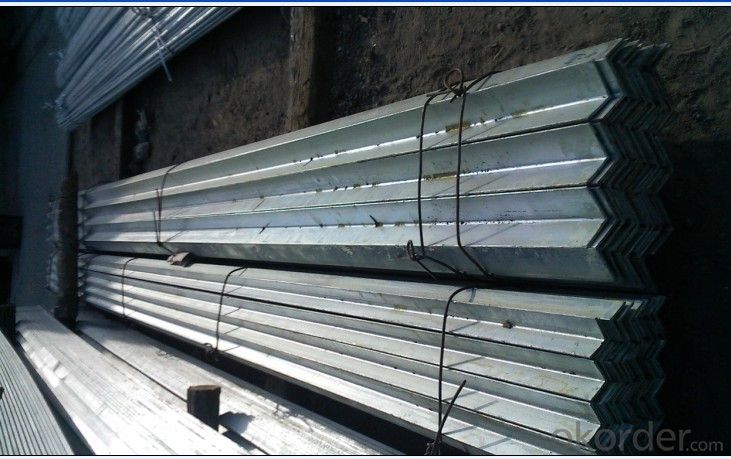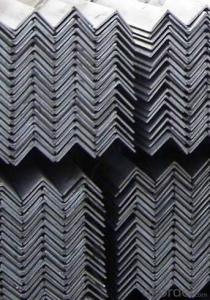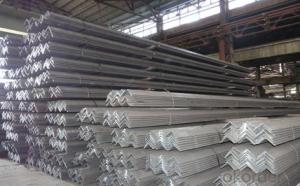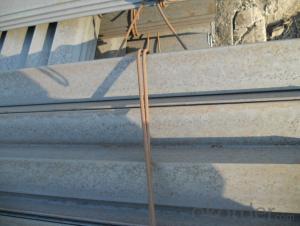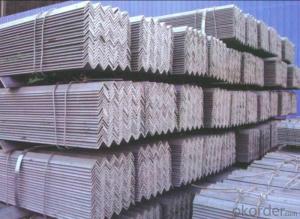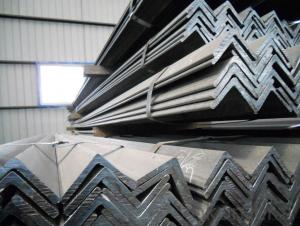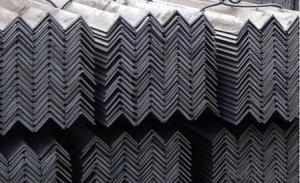Equal angle steel for sale
- Loading Port:
- Shanghai
- Payment Terms:
- TT OR LC
- Min Order Qty:
- 50 m.t.
- Supply Capability:
- 10000 m.t./month
OKorder Service Pledge
OKorder Financial Service
You Might Also Like
Product Description:
Specifications of Equal Angle Steel
1.Standards:GB,ASTM,BS,AISI,DIN,JIS
2.Length:6m,9m,12m
3.Material:GBQ235B,Q345BorEquivalent;ASTMA36;EN10025,S235JR,S355JR;JISG3192,SS400;SS540.
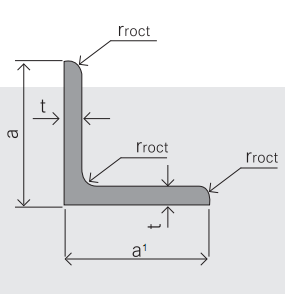 .
.
4.Sizes:
EQUAL ANGLES SIZES | |||
a(mm) | a1(mm) | thickness(mm) | length |
25 | 25 | 2.5---3.0 | 6M/12M |
30 | 30 | 2.5---4.0 | 6M/12M |
38 | 38 | 2.5 | 6M/12M |
38 | 38 | 3.0---5.0 | 6M/12M |
40 | 40 | 3.0---6.0 | 6M/12M |
50 | 50 | 3 | 6M/12M |
50 | 50 | 3.7---6.0 | 6M/9M/12M |
60 | 60 | 5.0---6.0 | 6M/9M/12M |
63 | 63 | 6.0---8.0 | 6M/9M/12M |
65 | 65 | 5.0---8.0 | 6M/9M/12M |
70 | 70 | 6.0---7.0 | 6M/9M/12M |
75 | 75 | 5.0---10.0 | 6M/9M/12M |
80 | 80 | 6.0---10.0 | 6M/9M/12M |
90 | 90 | 6.0---10.0 | 6M/9M/12M |
100 | 100 | 6.0---12.0 | 6M/9M/12M |
120 | 120 | 8.0-12.0 | 6M/9M/12M |
125 | 125 | 8.0---12.0 | 6M/9M/12M |
130 | 130 | 9.0-12.0 | 6M/9M/12M |
140 | 140 | 10.0-16.0 | 6M/9M/12M |
150 | 150 | 10---15 | 6M/9M/12M |
160 | 160 | 10---16 | 6M/9M/12M |
180 | 180 | 12---18 | 6M/9M/12M |
200 | 200 | 14---20 | 6M/9M/12M |
5. Material details:
Alloy No | Grade | Element (%) | |||||
C | Mn | S | P | Si | |||
Q235 | B | 0.12—0.20 | 0.3—0.7 | ≤0.045 | ≤0.045 | ≤0.3 | |
Alloy No | Grade | Yielding strength point( Mpa) | |||||
Thickness (mm) | |||||||
≤16 | >16--40 | >40--60 | >60--100 | ||||
≥ | |||||||
Q235 | B | 235 | 225 | 215 | 205 | ||
Alloy No | Grade | Tensile strength (Mpa) | Elongation after fracture (%) | ||||
Thickness (mm) | |||||||
≤16 | >16--40 | >40--60 | >60--100 | ||||
≥ | |||||||
Q235 | B | 375--500 | 26 | 25 | 24 | 23 | |
Usage & Applications of Equal Anlge Steel
Trusses;
Transmission towers;
Telecommunication towers;
Bracing for general structures;
Stiffeners in structural use.
- Q: Can steel angles be used in staircases?
- Yes, steel angles can be used in staircases. Steel angles are commonly used as structural elements in construction due to their strength and versatility. In staircases, steel angles can be used to provide support and stability to the steps and handrails. They are often used as stringers, which are the inclined structural members that support the treads and risers of the staircase. Steel angles can also be used to reinforce the connections between the treads and risers, ensuring the structural integrity of the staircase. Additionally, steel angles can be used as handrails or balusters, providing a secure and durable railing system. Overall, steel angles offer a reliable and cost-effective solution for constructing staircases that can withstand heavy loads and meet the necessary safety standards.
- Q: Can steel angles be used for signposts and traffic signals?
- Yes, steel angles can be used for signposts and traffic signals. Steel angles are commonly used in construction and engineering projects due to their strength and durability. They provide excellent support and stability, making them suitable for applications such as signposts and traffic signals that need to withstand various weather conditions and potential impacts. Additionally, steel angles can be easily customized and fabricated to meet the specific requirements of different signpost and traffic signal designs, making them a versatile choice for these structures. Overall, steel angles are a reliable and commonly used material for signposts and traffic signals due to their strength, durability, and versatility.
- Q: Can steel angles be used in storage rack systems?
- Yes, steel angles can be used in storage rack systems. Steel angles provide strength and stability, making them suitable for supporting heavy loads in storage racks. They can be used to create the framework and support beams in the rack system, ensuring durability and safety.
- Q: Can steel angles be used in seismic applications?
- Absolutely, seismic applications can definitely make use of steel angles. Thanks to their exceptional strength and ductility, steel angles are widely utilized in seismic applications. Specifically, they are commonly incorporated into the construction of steel moment frames and bracing systems, which are specifically engineered to counteract the lateral forces brought on by seismic events. In regions that are susceptible to earthquakes, steel angles prove to be particularly advantageous in terms of providing structural support and stability. They can be employed as diagonal braces, gusset plates, or stiffeners to enhance the seismic performance of buildings and other structures. Moreover, steel angles boast the added benefit of being easily fabricated and installed, making them an economical choice for seismic applications.
- Q: How do you join two steel angles together?
- One common method to join two steel angles together is by using bolts or screws. The angles can be aligned and holes can be drilled through both angles at the desired connection points. Then, bolts or screws can be inserted through the holes and tightened to securely fasten the angles together. Additionally, welding can also be used to join two steel angles together.
- Q: Can steel angles be used in the construction of museums?
- Yes, steel angles can be used in the construction of museums. Steel angles are commonly used in the construction industry for their strength and versatility. They provide structural support and stability to buildings, making them suitable for various applications, including museums. In the construction of museums, steel angles can be used in several ways. They can be used as framing members for walls, ceilings, and floors, providing a strong and durable structure. Steel angles can also be used as support brackets for shelves, display cases, and mounting systems for artwork or exhibits. Additionally, steel angles can be used in the construction of staircases, ramps, and walkways within museums, ensuring safe and secure access for visitors. They can also be utilized for the fabrication of structural elements such as beams, columns, and trusses, enhancing the overall stability and load-bearing capacity of the museum. Moreover, steel angles offer design flexibility, allowing architects and engineers to create intricate and aesthetically pleasing structures within museums. They can be easily customized and fabricated into various shapes and sizes to meet specific design requirements. Overall, steel angles are a reliable and efficient choice for the construction of museums. They provide the necessary strength, stability, and design versatility required for creating functional and visually appealing spaces to showcase art, artifacts, and exhibits.
- Q: Can steel angles be used in conveyor belt supports?
- Indeed, the utilization of steel angles is viable for the support of conveyor belts. Given their robustness and long-lasting qualities, steel angles hold a significant position as structural supports across numerous applications. Their exceptional ability to bear heavy loads renders them suitable for accommodating conveyor belts. By employing steel angles, one can establish a solid framework or structure that ensures the conveyor belt remains stationary while facilitating its smooth movement. Moreover, the convenience of fastening or welding steel angles together ensures a secure and stable support system for conveyor belts.
- Q: What are steel angles used for?
- Steel angles are commonly used in construction and engineering applications for providing structural support, reinforcing corners, framing, and bracing various structures such as buildings, bridges, and machinery.
- Q: Double angle steel rod in the corners of the roof steel why need to set the plate?
- A rod is a member of a much larger dimension than a horizontal (vertical) direction. The beams, columns and other components in the building are generally abstracted as rods. The shape and size of the rod can be described by two major geometric elements, the cross section and the axis of the rod. A cross section is a vertical section perpendicular to the length of the bar, and the axis is the center of each cross section. The cross section and the axis of the rod are perpendicular to each other. A rod with the same axis and straight line and cross section is called a straight rod with equal section. Building mechanics and mechanics of materials are mainly concerned with equal section straight bars. The bar whose cross section changes along the axis is called a cross section bar.
- Q: What is the minimum length of a steel angle?
- The minimum length of a steel angle can vary depending on the specific requirements and applications. However, in general, the minimum length is typically around 6 inches or 150 mm.
Send your message to us
Equal angle steel for sale
- Loading Port:
- Shanghai
- Payment Terms:
- TT OR LC
- Min Order Qty:
- 50 m.t.
- Supply Capability:
- 10000 m.t./month
OKorder Service Pledge
OKorder Financial Service
Similar products
Hot products
Hot Searches
Related keywords
